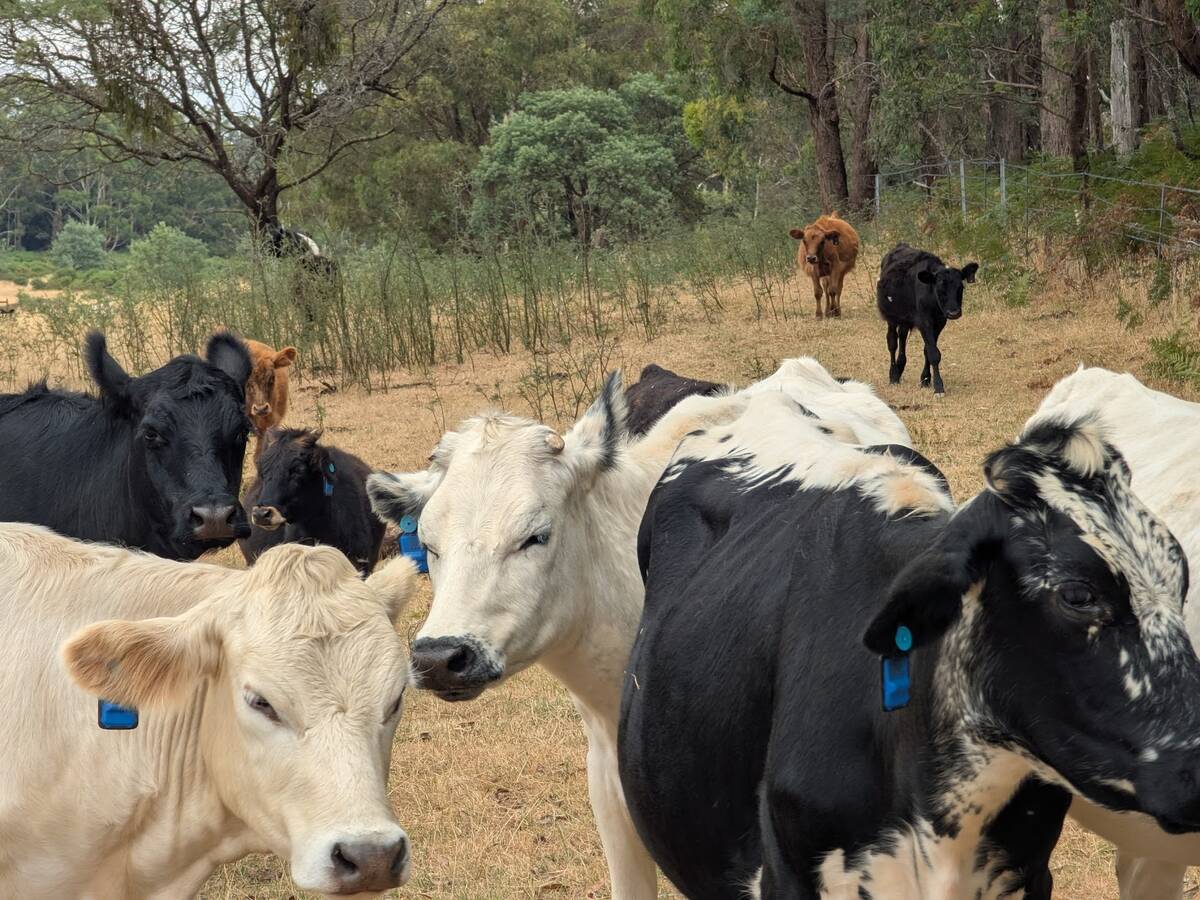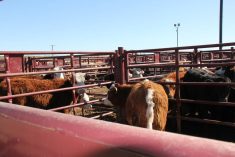The composition of feeds, forages and feces has traditionally been determined using wet chemistry methods, often referred to as the gold standard. However, the trade-off for this level of accuracy is often a high cost and a long turnaround time to perform the analysis.
In that time, the nutrient profile of forages in grazing systems may have changed substantially, while in a feedlot setting a load of feed ingredients may be already consumed, reducing the usefulness of the data for real- time management decisions. Near-infrared spectroscopy (NIRS) can bridge this gap by quickly providing reliable, accurate and cost-effective results.
NIRS is often considered to be a black box, a complex piece of equipment whose operation is a mystery to the user. Unfortunately, operating a NIRS is not a simple plug-and-play, but a basic understanding will help demystify this technology.
Read Also

Australian company brings ear-tag tech to Canadian pastures
With Smart Paddock, beef farmers and ranchers can track their cattle through GPS technology
NIRS 101
Waves of the electromagnetic spectrum surround us constantly, allowing us to see or hear. Organic molecules containing hydrogen and C=O bonds are capable of absorbing radiation from the NIR region (400 to 2,500 nm) of the electromagnetic spectrum. This energy transfer can be graphed as absorption against wavelength and is called spectrum. As each molecule has a unique absorption pattern related to its bond content, spectrum provides a unique fingerprint of each sample. Using chemometrics — science which uses mathematics, statistics, physics and other methods to analyze chemical data — we can relate this fingerprint to wet chemistry analysis and develop a calibration to predict the content of new samples with similar spectra.
Dried and ground samples of forages and feeds were originally used to develop NIRS calibrations, and while that remains standard in many cases, NIRS is also capable of predicting the composition of undried and unground samples. Robust calibration datasets include samples representative of the range of variation expected in the constituent or nutrient of interest. By increasing the number of spectrally different samples in a calibration, the calibration is better able to predict a new sample. In other words, the calibration is more likely to accurately predict spectra similar to what it has seen before.
Additionally, since NIRS requires data from wet chemistry analysis to make a prediction, we must be careful in laboratory selection for reference wet chemistry analysis. As every analysis contains a certain amount of error — whether it is related to sampling, methodology or some other uncontrolled factor — controlling laboratory error and removing outlier or redundant samples or spectra increases prediction accuracy by reducing the errors included in the calibration.
Once you have selected samples and obtained spectra, you use specialized software to develop regression prediction equations between the spectra and laboratory analysis. Equations must have a high level of accuracy and low error rate to be considered acceptable. All calibrations require ongoing validation and development as forages and feed ingredients can change over time.
Fit statistics are calculated for each sample, which helps identify outliers or abnormal spectra. Outliers are often considered good candidates for expanding the data set as they contribute variation to the calibration.
The final validation of any analysis, whether it is completed by NIRS or wet chemistry, should be a critical evaluation — do the results make sense in comparison to the expectation, whether that is a book value, a historic value or an estimate based on evidence related to a particular sample?
The commonly advertised advantages of NIRS include its ability to provide rapid and accurate sample analysis. This is due to the ease of sample preparation, wide application and scanning speed. Depending on sample preparation requirements, the entire process may take less than a minute, in comparison to the days a wet chemistry analysis may require. Subsequently, a larger number of samples can be processed in the same amount of time which has the added benefit of reducing the cost per sample. Finally, NIRS has a low environmental footprint as it does not require harsh chemicals for analysis. It also preserves the original sample.
Alternately, as previously mentioned, NIRS requires wet chemistry analysis for calibration, which means poor wet chemistry analysis will result in poor calibration equations. Calibration development and maintenance can also be problematic as they are not automated and require specialized software and trained personnel. A final disadvantage of NIRS is the initial equipment cost which can be quite high. However, the low maintenance requirement and high sample throughput help offset this expense.
Using NIRS for feed
The use of NIRS technology for forage and feed ingredient analysis has been adopted by commercial and research laboratories globally. Calibrations exist for most common parameters (e.g. moisture, protein, ADF, NDF, starch, etc.) for grain and pulse crops, byproducts including dried distiller grains, millrun, canola meal, and a wide range of forages. More recently, robust calibrations for quality properties such as digestibility and TDN or net energy values, reflective of the nutritive value to the animal, have been developed.
When can NIRS be employed, and when should wet chemistry be used? Due to the ability of NIRS to provide rapid analysis, it is a great tool for managing feeds with quickly changing variations. Chemistry analysis should be saved for inorganic analysis, analysis of novel forages or ingredients, and unique or unconventional samples where abnormal results may be expected. Some examples could include mineral analysis, unconventional forages which may appear during times of feed shortage and not fit the calibration profile, or if excess nitrates are suspected.
Laboratories often create test packages containing NIRS and wet chemistry separately, or in combination. Select required nutrients or quality parameters to support your production and management strategies and reflect the key requirements of the nutritional program employed by your operation. Grazing cow-calf producers will have different requirements from a finishing feedlot, and the strategies may change by year or by time of year. Generally, the nutrients of interest are those that promote the greatest variation in the feed and those that are used for energy estimates or calculations. This should be a well-defined and specific list, which your nutritionist can help identify, and will help determine the best combination of analysis or test packages for your sample. Ultimately, identifying the test package that provides the information required by your nutrition program can save a lot of time and money.
As the main requirement for NIRS is an organic bond, it has a wide and varied application in non-agricultural industries including medicine, pharmaceuticals, oil and gas, and others. However, NIRS has and continues to be used in many new areas of opportunity in agriculture. Recently, NIRS has been used to indirectly predict the quality of ingested forage from feces. In theory, as diets change, the byproducts of digestion also change, and these changes may be related to the chemical properties of the primary feed. People have developed robust calibrations to predict the composition, nutrient digestibility and intake of forages from dried and ground feces which may be of great value in grazing production systems. Additionally, there is preliminary evidence that the same calibrations may be developed from fresh or semi-dried feces, which would provide a great benefit to producers and laboratories alike in reducing the amount of sample preparation and returning results even quicker. This type of analysis, as well as the application of NIRS in assessing quality and carbon content of soils, is valuable as environmental stewardship and nutrient thresholds become increasingly critical to manure management.
Particle size calibrations to assess hammer-mill wear and to increase consistency in grind, which is particularly important for swine and poultry feeds, are recent developments in the feed industry. Combined with new and increasingly accurate hand-held and portable instruments, NIRS has and will continue to be a critical tool in feed manufacturing. Furthermore, some applications for inline NIRS ingredient analysis that were originally used by the feed industry are beginning to appear in conjunction with GPS capability on farm implements, allowing for increasingly precise agronomic practices.
A clearer understanding of NIRS, what it is, how it works, and some of its strengths and weaknesses allows producers and nutritionists to use it to their advantage. NIRS provides quick and reliable analysis for forages and feed ingredients, which can reduce over- or underfeeding and nutrient waste, resulting in better animal performance, efficiency and cost savings.

















